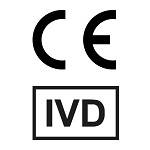
Gomori's trichrome stain
Gomori trichrome was developed by George Gomori in 1950.
This staining is intended to identify an increase in collagen fibers in the connective tissue or to differentiate between collagen and smooth muscle fibers.
The principle of Gomori trichrome staining is based on single-step staining. A plasma dye (2R chromotropic) and connective tissue fiber dye (fast green FCF, light green or aniline blue) are combined in a solution of phosphotungstic acid in which glacial acetic acid is added. Phosphotungstic acid promotes red staining of muscles and cytoplasm. Tungstate ions are specifically absorbed by collagen, and connective tissue fiber staining is then bound to this complex, staining collagen in green or blue, depending on the counterstain used.
Here are some examples of colorations obtained with Gomori trichrome:
- Nuclei: Black
- Cytoplasm, keratin, muscle fibers: Red
- Collagen, mucus: green or blue
Search result : 11 product found
Refine your search :
RUOCE / IVD
- Unconjugated 5
- kit 9
- Buffers and reagents 2
- IHC 5
Cat#
Description
Cond.
Price Bef. VAT
‹
1
›


